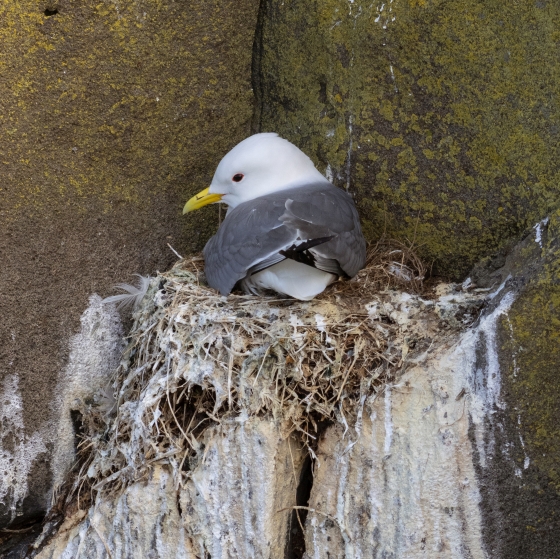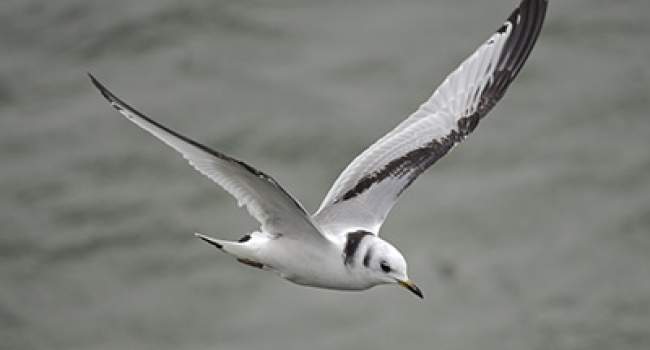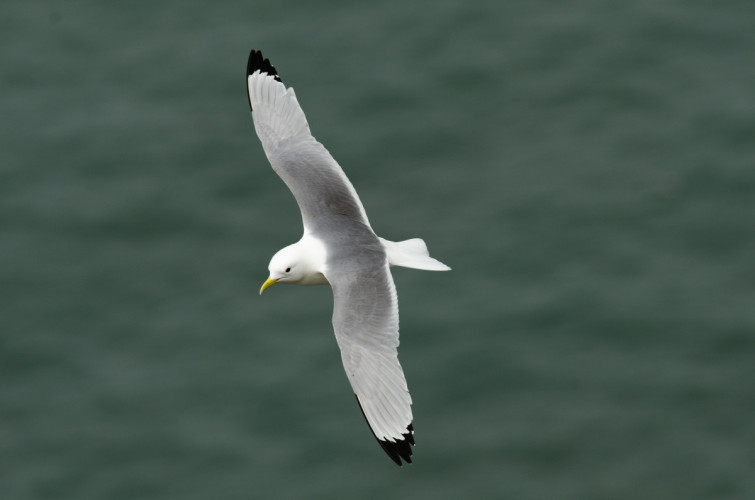Kittiwake
Rissa tridactyla (Linnaeus, 1758)
KI
 KITTI
KITTI  6020
6020

Family: Charadriiformes > Laridae

This medium-sized seabird is our most numerous gull species, and also our most maritime, spending much of the non-breeding season on the high seas of the Atlantic Ocean.
Breeding adults have a white head and body with a mid-grey mantle and wings. They also have distinctive, jet black 'ink-dipped' wing tips. Kittiwakes take three years to attain full adult plumage.
The main breeding strongholds are in Scotland, especially Orkney, Shetland and the north-west coast.
Identification
Kittiwake identification is often straightforward. The following article may help when identifying Kittiwake.
Identifying Kittiwake and other small gulls

Young Kittiwakes have a distinctive wing pattern, but several sought-after rarer species have similar markings - how can you tell them apart?
This video looks at several Gulls in juvenile plumage- Kittiwake, Little Gull, Black-headed Gull, Sabine's Gull and Ross's Gull.
SONGS AND CALLS
Listen to example recordings of the main vocalisations of Kittiwake, provided by xeno-canto contributors.
Other
Flight call
Call
Develop your bird ID skills with our training courses
Our interactive online courses are a great way to develop your bird identification skills, whether you're new to the hobby or a competent birder looking to hone your abilities.
Browse training coursesStatus and Trends
Population size and trends and patterns of distribution based on BTO surveys and atlases with data collected by BTO volunteers.
CONSERVATION STATUS
This species can be found on the following statutory and conservation listings and schedules.
POPULATION CHANGE
The Kittiwake population increased by 24% between the 1969–70 and 1985–88 Censuses, but these increases had been reversed by the time of Seabird 2000 (1998–2002). Ongoing annual monitoring show that further substantial declines have since occurred and it is expected that the results of the Seabirds Count (2015–2021) will confirm this (JNCC 2022)
DISTRIBUTION
Kittiwakes predominantly breed on coasts with rocky cliffs, though man-made structures can be used, including the only colonies in East Anglia. The highest densities are on the British east coast, particularly between Flamborough Head and Orkney. Kittiwakes are mostly pelagic in the non-breeding season so most winter records are from vantage points along the British and Irish coastlines. During 2007–11 concentrations were greatest in southwest Ireland, southwest Wales and the Northern Isles.
Occupied 10-km squares in UK
| No. occupied in breeding season | 249 |
| % occupied in breeding season | 8.2 |
| No. occupied in winter | 584 |
| % occupied in winter | 19 |
European Distribution Map
DISTRIBUTION CHANGE
Since the 1970s Kittiwake range has contracted by 10%, associated with an almost halving of the British breeding population. Losses are thought to be associated with changes in prey availability.
Change in occupied 10-km squares in the UK
| % change in range in breeding season (1968–72 to 2008–11) | -9.6% |
| % change in range in winter (1981–84 to 2007–11) | --31.4% |
SEASONALITY
Kittiwakes are recorded year-round, though more consistently in the breeding season on coasts near breeding areas.

Movement
Information about movement and migration based on online bird portals (e.g. BirdTrack), Ringing schemes and tracking studies.
RINGING RECOVERIES
View a summary of recoveries in the Online Ringing Report.
Foreign locations of birds ringed or recovered in Britain & Ireland

Biology
Lifecycle and body size information about Kittiwake, including statistics on nesting, eggs and lifespan based on BTO ringing and nest recording data.
SURVIVAL & LONGEVITY
View number ringed each year in the Online Ringing Report
Maximum Age from Ringing 
|
28 years 6 months 5 days (set in 1993) 
|
Typical Lifespan 
|
12 years with breeding typically at 4 year |
Adult Survival 
|
0.882  
|
Juvenile Survival 
|
0.79 (in first year) 
|
BIOMETRICS
Wing Length 
|
Adults | 308.2±8.9 | Range 295–322mm, N=483 |
| Juveniles | 284.2±15.1 | Range 258-304mm, N=44 |
Body Weight 
|
Adults | 368±37.5 | Range 310–434g, N=358 |
| Juveniles | 307±50.4 | Range 210–370g, N=44 |
Feather measurements and photos on featherbase 
CODES & CLASSIFICATION
Ring size 
|
E |
Field Codes 
|
2-letter: KI | 5-letter code: KITTI | Euring: 6020 |
For information in another language (where available) click on a linked name
Research
Interpretation and scientific publications about Kittiwake from BTO scientists.
CAUSES AND SOLUTIONS
Causes of change
There is good evidence that the declines in the Kittiwake population are likely to have been driven by low breeding productivity which is likely to be related to changes in sandeel populations (Coulson 1983, Frederiksen et al. 2005, Coulson 2017, McMurdo Hamilton et al. 2016). Sandeel stocks, and therefore breeding success of Kittiwakes and other seabirds, may be affected by the impact of fisheries and also by changes to sea surface temperatures due to climate change. Hence, management of fisheries may be necessary to maintain Kittiwake populations (Furness & Tasker 2000).
PUBLICATIONS (4)
Field metabolic rates of Kittiwakes Rissa tridactyla during incubation and chick-rearing

Methods to quantify avian airspace use in relation to wind energy development
Assessing the effects of wind farms on wildlife
New research involving BTO has developed a framework to identify how wildlife might be affected by renewable energy developments.
Stage-dependent foraging in breeding black-legged kittiwakes Rissa tridactyla: distinguishing behavioural responses to intrinsic and extrinsic factors

Trial of the use of silicone cord leg-loop harnesses on Black-legged Kittiwake during the 2023 breeding season
Testing harness designs for tracking seabirds
Links to more studies from ConservationEvidence.com
- Survival of least tern chicks hatched on gravel-covered roofs in north Texas
- An experimental study of nest site selection in common terns
- Calcium supplementation of breeding birds: directions for future research
Read more studies about Kittiwake on Conservation Evidence >
Would you like to search for another species?












Share this page